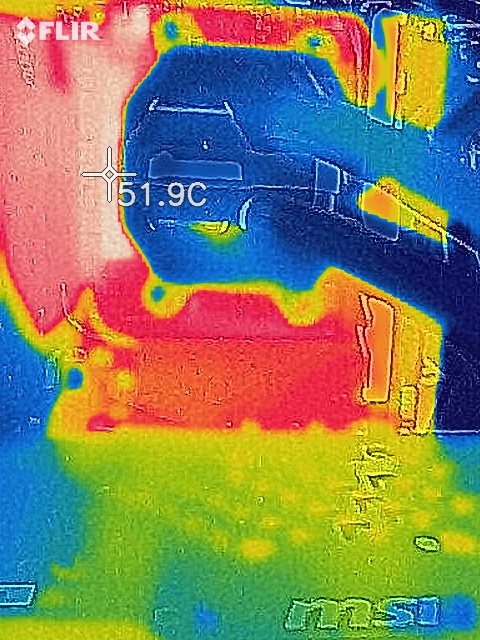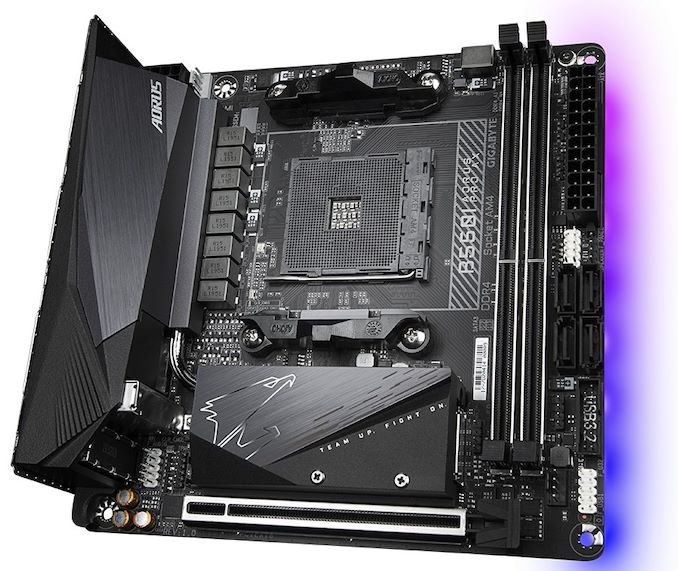The GIGABYTE B550I Aorus Pro AX Motherboard Review: All The Small Things
by Gavin Bonshor on December 7, 2020 10:00 AM EST_678x452.jpg)
Sometimes less is more, and when it comes to motherboards the mini-ITX form factor has some of the most enthusiastic fan club members. Small form factor systems are becoming more widely used as we're ushered into a single graphics card setup dominated landscape. and in terms of features to price, the B550 chipset has some of the most cost-effective of any current desktop platform. One such board is the GIGABYTE B550I Aorus Pro AX which combines a wave of premium features combined with AMD's B550 chipset. It includes compatibility for PCIe 4.0 devices with supported processors, dual PCIe M.2 slots, and 2.5 gigabit Ethernet. It's time to give our verdict on it and see if it can cut it in a very competitive small is more market.
GIGABYTE B550I Aorus Pro AX Overview
One of GIGABYTE's most scalable ranges is its Aorus series, which typically aims its feature set and aesthetics at gamers. Often clad in RGB enabled heatsinks and componentry, the Aorus series is now GIGABYTE's most widely recognizable range, which stretches from the larger E-ATX to small-sized mini-ITX offerings in motherboards, but also covers graphics cards, laptops, and all manner of other components.
Focusing on the mini-ITX form factor, the range on offer is considerably more competitive than the ATX market for a couple of reasons. The first is that there are much fewer small form factor models available, meaning manufacturers are limited in what they can do and need to strive to get the right solution, sometimes at the first time of asking. The second is that with less to choose from, it's key in getting a model that fits the desired feature set and for the rest of the hardware to fit the whole aspect of a system build.
Less is more in some cases, but fewer PCIe slots available means less room for the addition of controllers such as networking, storage, and other devices. Focusing primarily on what the GIGABYTE B550I Aorus Pro AX has to offer, it blends subtle black and grey tones for an elegant look, with the board's integrated RGB located along the right-hand side of the board for a rainbow infused under glow effect. While having a look that should fit into most systems in terms of aesthetics, the mini-ITX Aorus Pro AX has plenty of features. This includes a PCIe 4.0 x4 M.2 slot located on the front and a PCIe 3.0 x4/SATA M.2 slot on the rear, with four SATA ports, and two memory slots capable of support up to DDR4-5100 memory, with a total capacity of 64 GB. Looking at networking, it uses a premium 2.5 GbE controller with a Wi-Fi 6 interface pairing. Simultaneously, the onboard audio solution is also good, which one expects from a mid-range model.
Putting the GIGABYTE through our testing suite, the B550I Aorus Pro AX performed well in the majority of our system tests, with good showings in all three power tests, as well as in our POST time testing. DPC latency performance was average at best, and it performed competitively when compared to other AM4 based models tested with our Ryzen 7 3700X processor in our CPU and gaming tests.

The GIGABYTE B550I Aorus Pro AX undergoing thermal VRM testing
In our overclock testing, the Aorus Pro AX performed as expected, with its premium 8-phase power delivery consisting of six 90 A power stages for the CPU VCore, and two 90 A power stages for the SoC. We saw good VDroop control under load, with consistent performance increases in our testing as we ran each frequency. Even under full-load with lots of CPU VCore to stress the power delivery, it performed very well for a mini-ITX sized model, with competitive temperatures when compared to other AM4 models.
The GIGABYTE B550I Aorus Pro AX plays to the strengths of the X570 chipset, as a B550 mini-ITX board can only include so much, so it benefits from the small form factor with full PCIe 4.0 support as opposed to an ATX sized variant. At present, the B550I Aorus Pro AX is available at Amazon for $179, which is a little cheaper than MSI's MPG B550I Gaming Edge WiFi model at $185, and ASRock's B550 Phantom Gaming-ITX/AX at $200. All three of these models, including similar feature sets, including premium integrated audio, 2.5 GbE networking, and Wi-Fi 6 capabilities. The end decision could come down to performance, memory compatibility, and other aspects such as power delivery, rear panel I/O connectivity, which all three models include respectable offerings, but for GIGABYTE's model, it's time to see how it stacks up against other model's we've tested.
Read on for our extended analysis and comparison tests.











76 Comments
View All Comments
meacupla - Tuesday, December 8, 2020 - link
yup, that's exactly what happens.The only remaining fix I could think of was replacing the soldered in BIOS chips
star-affinity - Tuesday, December 15, 2020 - link
Just wanted to say that my problems was resolved with a new power supply! So now the Gigabyte motherboard is working fine again, believe it or not. :)duploxxx - Tuesday, December 8, 2020 - link
not to mention cold boot - bios resets - unable to save q-fan profiles etc...I was very impressed by the x370 although it lacked some easy visual design.
The x570 gigabyte is not worth the money, would stay away from it as much as possible.
I also own an Asrock B450 board, a much better bios layout.
Dug - Tuesday, December 8, 2020 - link
Strange. I have Gigabyte going back to p965 with no issue.No issue with my x570 aorus pro wifi like you describe either, like thousands of others.
kkilobyte - Tuesday, December 8, 2020 - link
I - and others - have zero idea on what is triggering the issue. There is clearly something fishy going on with the power distribution on the Aorus X570, but so far, it was not possible to pinpoint the origin of it. ErP, USB load, PSU, DisplayPort, Sleep modes, RAM modules all have been suspected, but none of those elements led to anything conclusive. There is a +20 pages thread on hardforum.com about it. I tried to probe the issue with my scope, but it happens completely randomly; so far, it happened to me 3 times in about 8 months, and last time it happened, I was in a hurry and couldn't test.Doing a CMOS reset through the jumper doesn't solve the issue; it could thus mean that it is not a cmos-ram corruption, but a more fundamental electrical issue. My best bet is that somehow a power spike at shutdown is sometimes high enough to wrongly toggle a signal line that 'locks' one of the components kept alive by the battery.
Finding the solution would require identifying the components that are kept powered by the cmos battery; without precise motherboard schematics, however, that's going to be difficult; even if it gets identified, I don't see how it would be solved without some sort of hardware hacking.
My personal solution is to design an arduino-based circuit that plugs on the battery connector of the motherboard, and allows a 'reset' through a front panel button. It's less than ideal, but that's better than having to open the case and remove my gfx card just to get the battery out.
mkarwin - Tuesday, December 15, 2020 - link
Well if CMOS reset does not fix the issue there's either a failing BIOS chip or circuitry throughout the board's layers... Theoretically one could pinpoint the issue by replacing the BIOS chip...BTW. I honestly wonder why they haven't thought of putting BIOS(es) on microSD cards, some of those smaller ones would be dirt cheap nowadays and capacituous enough to handle modern UEFI BIOSes - easy to remove/replace/reflash, could maybe improve the consumer attitude towards the issue if it is related to BIOS chips...
hansip87 - Monday, December 7, 2020 - link
What i don't understand with AMD mini ITX board is how few are their USB ports available at the back. one of the reasons why i chose going intel route was that there is this cheap Asrock Z490 itx board with 8 USB ports at the back. Sure it;s not the only factor but why can't any of AMD ITX boards do the same?romrunning - Monday, December 7, 2020 - link
Well, you can always just get a plug-in USB hub if you need more. I think the mfgs don't add as many USB ports mostly as a cost-savings.mkarwin - Tuesday, December 15, 2020 - link
Seems quite odd considering they are still asking more ($) for less (size & features)... It's not like they're running out of space on I/O shield, there's no integrated massive cooling openings in most cases, so adding eg. 4 extra even 2.0 USB ports would be more beneficial than having 3 display outputs for the integrated Radeon solutions... I could see a future where more integrated display outputs is beneficial - if they allow adding those server/compute accelerators without display outputs so that they could pass through the display to those board integrated ports. Otherwise, I think maybe 1 HDMI is enough. Especially if you can use said HDMI to pass through audio from the integrated card as well...jeremyshaw - Monday, December 7, 2020 - link
Probably the massive AMD AM4 keep out area. It doesn't really matter for mATX and ATX, but for mITX, every mm^2 matters. But every B550 ITX board is flawed in some way.ASUS hates rear I/O altogether, ASRock ditches the S/PDIF and doesn't have all that many USB ports (still more than ASUS). Gigabyte's never head of USB-C headers, and MSI gets all of that right, but has a proprietary backplate.
X570 came out a year earlier and is worse in many ways. ASUS is pricing their top end board for people without sense, and all of the X570 mITX boards from all other vendors lack the USB-C header. All of them are also 1GbE only, which seems like a waste for such a fast platform. ASRock has TB3, but only one M.2 slot, and very few USB ports.
In the end, I've held off upgrading my old AB350 Fata1ity ITX, since nothing is really appealing w.r.t. upgrading (not to mention almost twice the price!). Ryzen 5000 might force my hand, but I'd still rather not "upgrade" to boards that are very flawed (IMO) vs their Intel counterparts.
On Intel, all is not perfect, but there are more "perfect" boards that don't have these same issues.